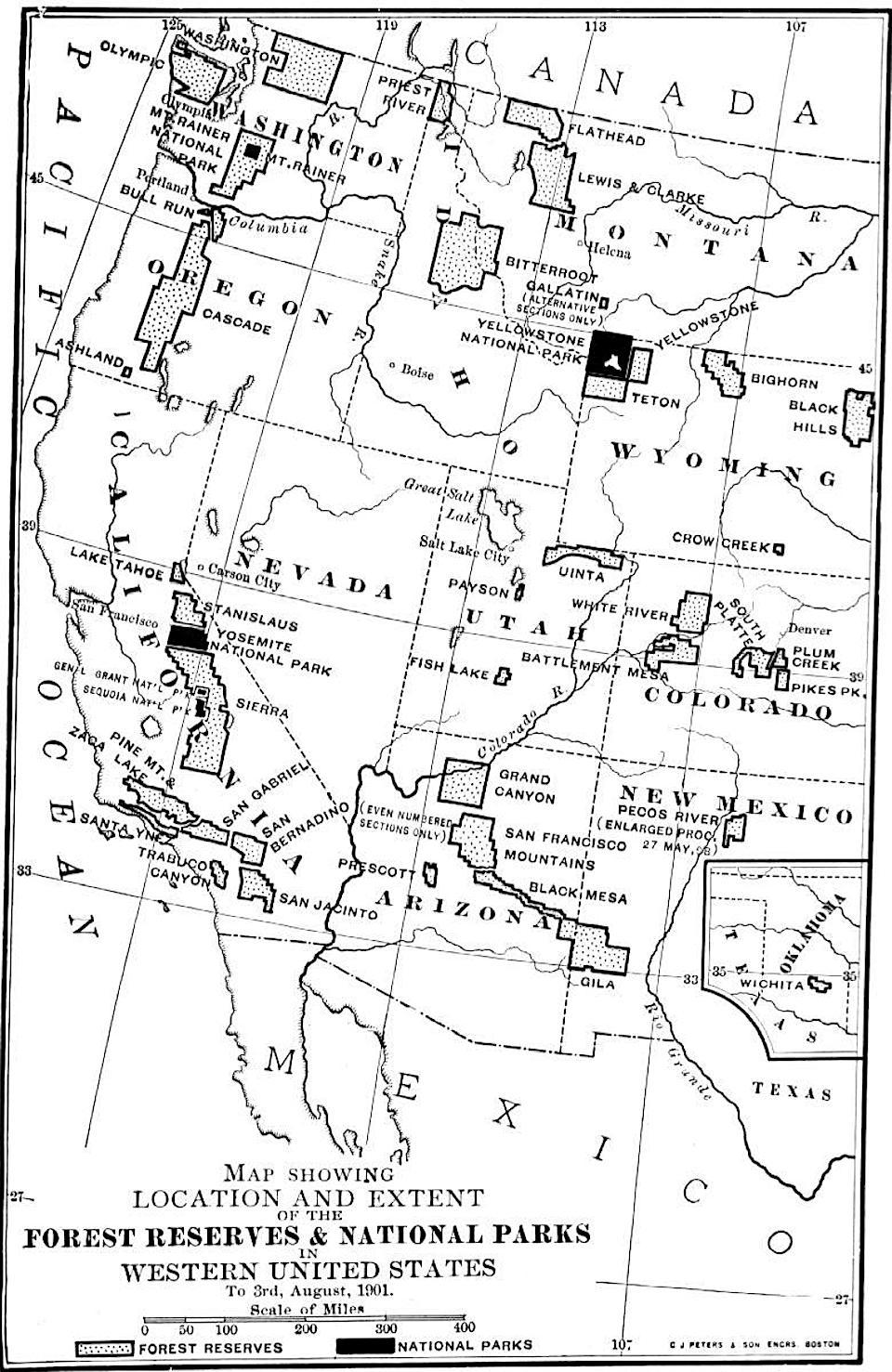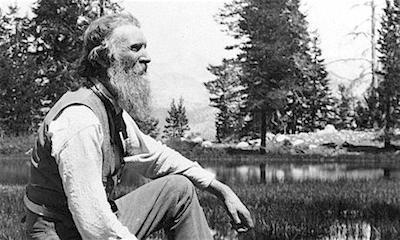
The military superintendent of Sequoia National Park in the 1890s, Capt. James Parker, was shocked by the devastation sheep were doing to the surrounding forests/NPS archives
Editor's note: John Clayton, author of Wonderlandscape: Yellowstone National Park and the Evolution of an American Cultural Icon, looked at the intersection of John Muir and Gifford Pinchot in his forthcoming book, Natural Rivals: John Muir, Gifford Pinchot, and the Creation of America’s Public Lands. The following piece comes out of the research for that book.
In June of 1894—125 years ago—Sequoia National Park Superintendent James Parker journeyed northwards to inspect the Sierra Forest Reserve. This mountainous country (now called the Sierra National Forest) had been set aside 16 months previously to protect its watersheds from overgrazing by sheep and over-cutting by timber interests.
Parker entered a disaster zone. Defying the new policy, sheep were everywhere—he estimated 500,000 of them on the forest as a whole. They had eaten so much grass that his packhorses couldn’t find enough for their daily rations.
The forest’s condition was “about as bad as it possibly could be,” Parker reported. Indeed, “were it not for the tall pine and tamarack trees, which the sheep cannot prey on, it might justly be termed a desert.”
It was a classic tragedy of the commons. Before 1891, most of the public domain was only temporary—such lands weren’t “public” so much as “not yet privatized.” So they weren’t managed or regulated. They were a literal free-for-all where sheepherders, loggers, and other capitalists reaped the natural resources without owning the consequences, which included denuded meadows, clearcut hillsides, and vanishing streamflows.
Similar stories emerged all over the country. The Yellowstone Timber Land Reserve was overgrazed, over-hunted, and even illegally homesteaded. But the superintendent of the adjacent national park complained that the forest reserve was too remote, too expansive, and too rugged to be effectively policed with his limited manpower. Yet other forest reserves lacked even nearby national parks to provide patrols. Instead, they were dependent on enforcement by the General Land Office. Then Congress cut the GLO’s investigation budget by 50 percent.
The crisis caused some to fear for the very future of nature. The seemingly inexhaustible forests and native grasslands of the Midwest and Great Plains had vanished. Once-ubiquitous species like the bison and passenger pigeon neared extinction. And all this consumption failed to promote Jeffersonian democracy, instead worsening income inequality.

At a time when just four national parks existed, America’s relationship to the natural world depended on these forest reserves (many of which would eventually become parks such as Kings Canyon, Grand Canyon, and Grand Teton). But because nobody could agree on a management philosophy for the reserves, the Interior Department decided to keep all people out of them. No sheepherding, no logging, no mining, no grazing, no homesteading, no hunting—no trespassing. One of Superintendent Parker’s packhorses carried 100 No Trespassing circulars. He posted them along the reserve’s western boundary. Half of them were torn down immediately.
The No Trespassing policy made nobody happy. Unpopular and unenforceable, it was also hard to justify: how could a democratic government, made up of the people, deny all people access to government land?
An eventual solution to the crisis emerged in part from unlikely collaborators, the naturalist John Muir and the forester Gifford Pinchot.

John Muir/LOC
Muir, the author and activist who defended Yosemite and other wild, natural places, used his rhetorical gifts to persuade the public of the value of having the government permanently own and aggressively manage its public lands. Yet Muir’s essays promoting these ideas were shaped less by his wilderness wanderings than by the forestry principles that he learned from Pinchot. Those principles, combined with Pinchot’s managerial genius as eventual founder of the U.S. Forest Service, gave federal authorities the regulatory legitimacy to curb use.
Today, ecologists are concerned that some forests in the Sierra and elsewhere may again turn into deserts—although this time the agent of change is climate rather than sheep. As in the 1890s, the path to a solution seems blocked by an apathetic public, greedy capitalists, a dysfunctional Congress, and a society caught up in issues of income inequality.
But the lesson of Muir and Pinchot is that solutions to intractable problems often arise from mergers of rivaling perspectives. When the preservationist Muir listened to the conservationist Pinchot, he produced some of his most eloquent and persuasive work. When the administrator Pinchot listened to those he disagreed with—including both the more-radical Muir and the more-capitalist grazing interests—he produced some of his most valuable governance.

Gifford Pinchot/NPS archives
Muir and Pinchot are often portrayed as rivals, with clashing philosophies about the preservation or use of natural resources. But in a time of environmental crisis, when America needed creative new approaches to its relationship with the natural world, the solution came from a combination of the prophet Muir’s moral storytelling and the statesman Pinchot’s political genius. We could use such rivals today.
John Clayton is the author of Natural Rivals: John Muir, Gifford Pinchot, and the Creation of America’s Public Lands, which will be published by Pegasus Books in August.




 Support Essential Coverage of Essential Places
Support Essential Coverage of Essential Places







Comments
I'll buy, read, and learn from Clayton's book, but right now I'd trade both Muir & Pinchot for a Aldo Leopold. Not the older Leopold of Sand County Almanac and his Land Ethic, 50 years after Muir and Pinchot, helping guide natural restoration of his logged & overgrazed land in Wisconsin. That 50 year difference is a unfair comparison, and allowing and assisting land to recover isn't applicable to what we face over the next 50 years. Rather, I want the younger Leopold of 1911-1933, contemporaneous with Muir and working in Pinchot's Forest Service. That Leopold was not just the blend of Muir's preservation and Pinochet's extraction/exploitation. More critically, he was willing to observe and learn over decades, and modify his views and action based on empirical observations. I recommend the U New Mexico collection "Aldo Leopold's Southwest" ("Aldo Leopold's Wilderness" in hardback), which illustrates his evolving understanding of fire-dependent forests of the southwest as well as of predators via his own writings over the years. What we want public lands to be, how NPS should manage "unimpaired for the enjoyment of future generations" in the face of climate change and pervasive aerial deposition, is not just an intractable political question. It's also a science and resource management question. We have decent understanding about how ecosystems are likely to change under different climate change scenarios. We have much less understanding of what management actions might nudge conditions more in the direction of our desired outcomes.
Finally, as a certified, degreed ecologist, I'd like to point out that no ecologist thinks Sierra forests will become deserts under any climate change scenario. The forest bands will contract, but primarily be replaced by several forms of shrublands.
Thanks for the thoughtful response! I wholeheartedly agree that Aldo Leopold's focus on ecological management makes him a fascinating and essential third leg of the Muir-Pinchot stool.
My source for the "some forests into deserts" claim was https://www.usgs.gov/center-news/climate-fire-and-forest-change-californ... "In some areas, forests may be replaced with shrublands, grasslands, or deserts." But as an amateur ecologist, I would be happy to defer to your slightly-less-pessimistic view. Thanks again for commenting.